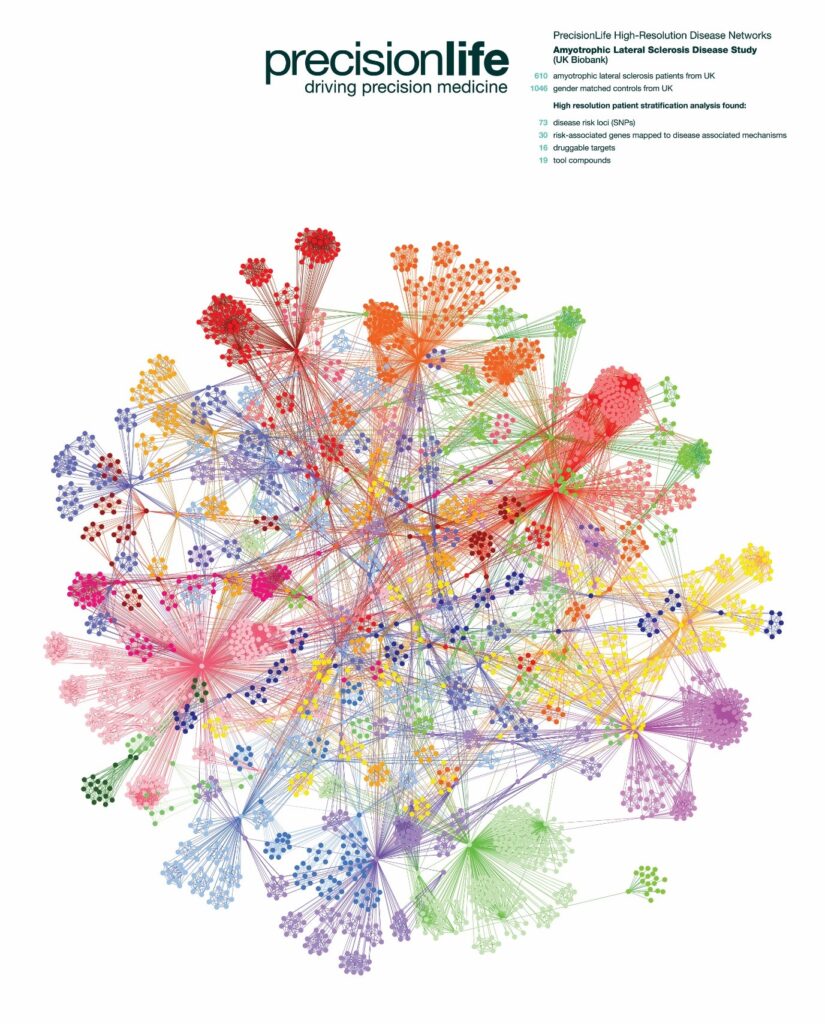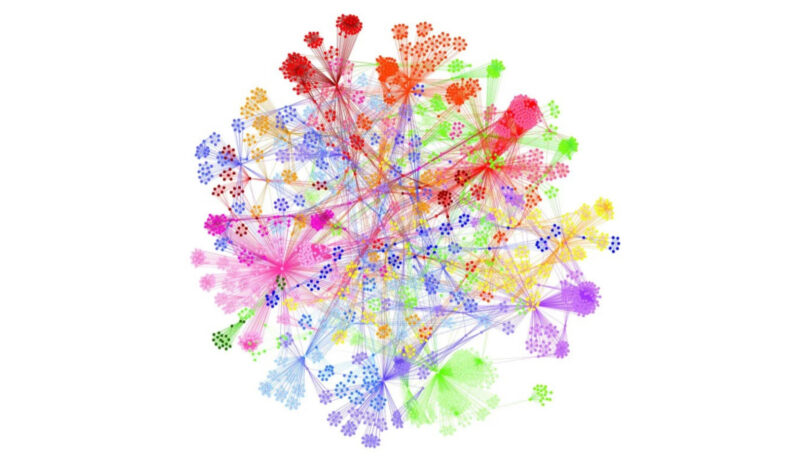“The search for new drugs to help MND patients is a long and challenging one, but it is one where we are beginning to see hope for the future emerging on several fronts. New Artificial Intelligence (AI) data analysis techniques and larger, more detailed collections of patient data have been pivotal in these advances.”
Dr Steve Gardner, CEO PrecisionLife Ltd
This year marks the twentieth anniversary of the announcement of the first draft of the Human Genome Project, a milestone achievement in scientific collaboration that promised to advance the discovery of novel drugs for multiple diseases. The intervening decades have seen transformational discoveries and developments in fields such as cancer, cystic fibrosis and other rare diseases that are often caused by single mutations in a patient’s DNA.
Genetic tests are now routinely used to screen and diagnose some cancers and to guide tailored treatment strategies, enabling doctors to choose the right drugs that will be most effective for a given patient’s tumour. This is a new branch of medicine called precision medicine, and it holds huge potential for alerting people to their risk of a disease and improving the treatment for patients once diagnosed.
Despite these great steps forward in cancer therapy, there is unfortunately still work to do in diseases such as MND. What we might think of as a single disease actually has a number of causes and influences and as we unravel the complexity of MND it is becoming obvious that the disease will present a mix of opportunities and challenges.
The discovery of large number of genes and mechanisms associated with MND allows us to advance our understanding of the disease and gives us more opportunities to find new drug targets and approaches to treating the disease. However, just as cancer is not one disease, it is probable that the different underlying causes and variable nature of MND symptoms between people means that it’s unlikely that any single drug will be equally effective in every person with MND. It’s more likely that when we do find new drug treatments, each one will help some patients more than others – and that we will need several different treatment options, just as we have in cancer, to treat the full range of patients. Some tailored therapeutics, based on an individuals’ genetics, have begun to emerge in clinical trials. Such an approach has the potential to be a more targeted and therefore effective therapeutic strategy for people with MND.

The picture (below) shows just how varied and complex the causes of MND are across a population of patients. This analysis was performed by PrecisionLife, a British company that has developed new AI analysis tools that give deeper insights into complex diseases, as part of a collaboration with the MND Association, Prof. Ammar Al-Chalabi’s lab at King’s College London and Dr Laura Ferraiuolo’s group at the Sheffield institute of Translational Neuroscience (SITraN). The study analysed genetic and clinical data from a population of UK patients in the Project MinE database and the MND Association’s MND Collections, an award-winning resource of biological samples collected from people living with MND and controls that is available for researchers to use to help find the causes of MND and potentially a cure.

Combinatorial analysis of an ALS patient cohort performed by PrecisionLife. Each circle represents a disease-associated genetic mutation; lines represent mutations that co-occur in the same patients; and colours represent distinct patient subgroups.
In this picture, the colours represent different subgroups of MND patients, and the tiny dots are individual changes in genes (called mutations) that are associated with the disease in that subgroup of patients. On the diagram, the points that connect many circles together show critical MND related genes. By understanding these genes’ roles both in MND and in the normal biology of a cell, their suitability as a drug target (their potential to be modulated by a drug with positive therapeutic effect and limited side effects) can be evaluated. This enables researchers to design novel drugs that will have an impact on one or more aspects of the disease.
This analysis shows that there may be up to eight different mechanisms in MND, each involving a different set of genes and possibly different cell types. Some may directly cause the disease, while others may affect the disease symptoms or its rate of progression. Interactions with other environmental factors, such as previous infections, diet, trauma and exposure to toxins may also play a significant role, although exactly which factors and how are still being investigated.
In this study, PrecisionLife identified 33 new genes associated with MND. This is a significant advancement that opens multiple new avenues for research. Working with SITraN and King’s, the PrecisionLife team tested potential drug candidates for five of the new targets and found three active compounds that showed potential to improve the survival of motor neurones, a key first finding in the hunt for new drugs.
“The use of AI to identify new targets or unravel disease mechanisms is an extremely fascinating and necessary development. We are excited about this collaboration and our initial results”
Dr Laura Ferraiuolo, Sheffield institute of Translational Neuroscience (SITraN)
“PrecisionLife were able to look at this genetic data in a completely new way and show possible subtypes of MND that might respond to specific targeted treatments. Once we confirm these subtypes, we can look at potential drugs that could be taken into clinical trials.”
Prof Ammar Al-Chalabi, King’s College London
This is a very early but encouraging result which may ultimately lead to effective new therapeutics for at least some people with MND. The next stage is to build on these early results and move into clinical trials with the goal of finding novel drug treatments that can slow down the progression of MND. The team is also identifying biomarkers which are measurable biological signatures, genetic and other features, that might be diagnostic for specific forms of MND or even predictive of disease risk or progression rate. These patient stratification biomarkers will be essential during clinical trials to ensure that the right patients are recruited into the trial so that the efficacy of the novel therapy can be demonstrated for that population.
This is one example of the many dedicated teams of researchers across the world working on this challenge. These researchers now have more information and better tools at their fingertips than at any point to date. Artificial intelligence (AI) and new data analytics technologies are playing a crucial role here. New platforms such as PrecisionLife allow combinations of genetic, clinical, environmental and epidemiological features to be evaluated, giving much deeper insight into the drivers of complex diseases like MND. These tools can spot new patterns and correlations across huge patient datasets that allow researchers to home in on the causes and potential treatments for MND.
The other key enabler of this research is of course people living with MND and healthy controls. Without their generous donations to the scientific community, new research and progress in finding new treatments would be all but impossible.
For more information on further studies investigating patient stratification in MND, please visit the PrecisionLife website. For copies of a poster showing the MND analysis, please contact info@precisionlife.com.






